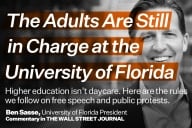You have /5 articles left.
Sign up for a free account or log in.
The primary value of federal commission reports on higher education is that they provoke an extensive discussion of almost everything. From angry complaints about cost and performance to deep philosophical discussions about purpose and methods, the blogs, testimony and discussion provide a common forum for our collective angst about college in America, highlighting the constant American dilemma of higher education as a business or a calling. This issue, illustrated by a helpful commentary recently on Inside Higher Ed, deserves more exploration that we usually provide.
Although most of us who do higher education as a profession see ourselves involved in a calling with a higher purpose than mere commerce, our ability to exercise our professional skills depends entirely on the operation of a complex, highly competitive, and remarkable diversified business environment. Universities and colleges do what all business enterprises in America do: They sell services and goods to consumers, earning the money to pay for the continued production of those services and goods. If they fail to provide high enough quality goods and services to enough consumers, they will lack the revenue to operate the business, and the college will fail. This is true whether the educational governance or ownership is public, private nonprofit, or private for-profit. These business enterprises must serve their customers and earn revenue or they will fail. They cannot seek a higher plane of existence without finding a market for their services.
What then of public purpose? The notion of public purpose is simply another way to describe a category of consumers of higher education services. Public purpose exists when the public, through the subsidy mechanisms of state and federal government, purchases some higher education services. When the legislature of a state or Congress makes the purchasing decisions it does so as consumers of higher education services. Governments, like parents and students, have specific purposes in mind when they purchase higher education services, purposes that may not be the same as those of parents and students. While we may choose to believe that the tax-based purchase of higher education is of a higher order than the individual consumer based purchase, the institutions themselves compete in both market niches to acquire the revenue needed to pay their employees and continue operations.
Over the last generation, as higher education has shifted from a luxury purchase for some citizens to a commodity purchase for a large percentage of citizens, the intense competition for these new consumers challenged the business models for many public and private institutions. The states, faced with rapidly escalating costs for social services and other high priority entitlements and resistance to tax increases, have been unable to increase their higher education purchases to meet a rising public demand. This leaves the direct consumers -- parents and students -- paying more for educational services. As the parents and students pay more, the institutions become more sensitive to the market place the parents represent. Institutional success comes from generating enough revenue to sustain itself and, if possible, to create a surplus to invest in quality improvements that will make it more competitive.
The key constraint in this business model, which differentiates it from the industrial models such as big steel or the highly consolidated industries such as banking, is that higher education is a profoundly individualized service. Higher education does not create a product in the traditional sense. Almost everything we provide in the way of educational content or product is available in your local library or on the Internet. The content is not the product; the service of faculty and staff to individual students, is the business of higher education. However, this is an interactive service that requires the participation of the direct consumer (the student) to achieve its result. While universities and colleges provide a rather standardized service (the four-year degree model regulated by accreditation agencies), the actual service delivered to each student depends on what the student wants, what the student does, and what the student brings to the process.
In the abstract, we may want students to read more, study harder, spend less time on extracurricular activities and more on writing. But when the students pay for a large part of the cost of the services, when the competition for customers is fierce, and when the public subsidy for all institutions, public or private, declines, there can be no other response than to adjust to customer expectations.
The corrective for excess responsiveness to student wishes is, of course, the multiple consumers who contribute to the purchase of every student’s education. While students may all want to earn 4.0’s, attend classes for a minimum amount of time, and write hardly at all, their parents (who pay some part), the public (which subsidizes some part), and the employers (who validate the utility of the education) all exert their influence on the process to achieve an outcome that reflects what the market place, taken together, wants from college.
When national crisis commissions convene periodically, they almost always represent the different perspectives of parents, employers, students, and the many quite different parts of the academic market place. When they try to make concise, national and effective policy statements about higher education, they usually find themselves speaking only to parts of the problem, or they propose sweeping generalizations that for all the drama of high rhetoric fail to adequately engage to the multiple issues that affect the many different aspects of the higher education market place.
The higher education environment in the United States appears somewhat chaotic, uncontrolled or out of control in the eyes of many, but in truth it actually functions as well as any other alternative we can imagine. Overseas competitors with highly centralized and controlled higher education bureaucracies find themselves struggling to introduce market competitive systems to make their institutions competitive on a global basis, recognizing that centralized subsidization and control of higher education produces consistency at a high cost and relatively low productivity.
The American model has the peculiarity that it permits anyone to attempt higher education at some level and in some place. The commitment to opportunity pushes the competency filter to the educational institution, where in other countries the filter takes place much earlier in the process, and eventually to postgraduation testing (for professional programs) or employment criteria in various industries. This commitment to preserving opportunity creates the highly varied nature of higher education in America. This commitment requires low completion rates in many institutions as open opportunity meets the requirements of academic performance. This commitment creates a market for institutions producing graduates of considerably different preparation levels, leading to postgraduation tests such as the GRE, the MCAT, the LSAT, and various professional examinations to determine specific levels of competency for various purposes.
If we recognize that the business model for American higher education is a service business that serves students individually because it requires their engagement to produce the desired result; that higher education in America is an open opportunity industry that finds a place for every willing student however well or poorly prepared or capable; that higher education in this country competes for customers in every public and private market place available; then we can better understand how to improve the operation of the many different parts of what we call higher education without damaging this basic model, with all of its benefits.
We can provide better data, externally audited and verified, on aspects of our performance to help individual and public consumers of our services understand what we do. We can price our services to students and to public consumers (legislatures) clearly, eliminating the complex discounting mechanisms that breed suspicion of discrimination and manipulation. We can better define the multiple outcomes expected from a student’s purchase of our services, for there is no longer any such thing as a “college education” but multiple outcomes related to majors in the sciences, the humanities, the social sciences, and the professions.
We cannot become a single, unified, and homogeneous government controlled national public service. We cannot apply a single standard of performance to all postsecondary institutions. We cannot accept lowest common denominator tests of reading, writing and thinking as the national standard of collegiate academic achievement. We should do things that enhance the effectiveness of each different part of higher education, recognizing that what we can do in one part of the market place will have no benefit in other parts. This approach requires careful attention to purpose, clear articulation of the measures of success, and accurate data to reflect performance in achieving the purpose.
The message of these periodic crisis commissions, a common fixture of American higher education, is that we have a great reluctance to speak clearly about the highly differentiated nature of this industry and the wide, and appropriate, variations in services and outcomes that can and should be expected of the various market segments.
As is usual in such conversations, we have met the challenge and it is us.








